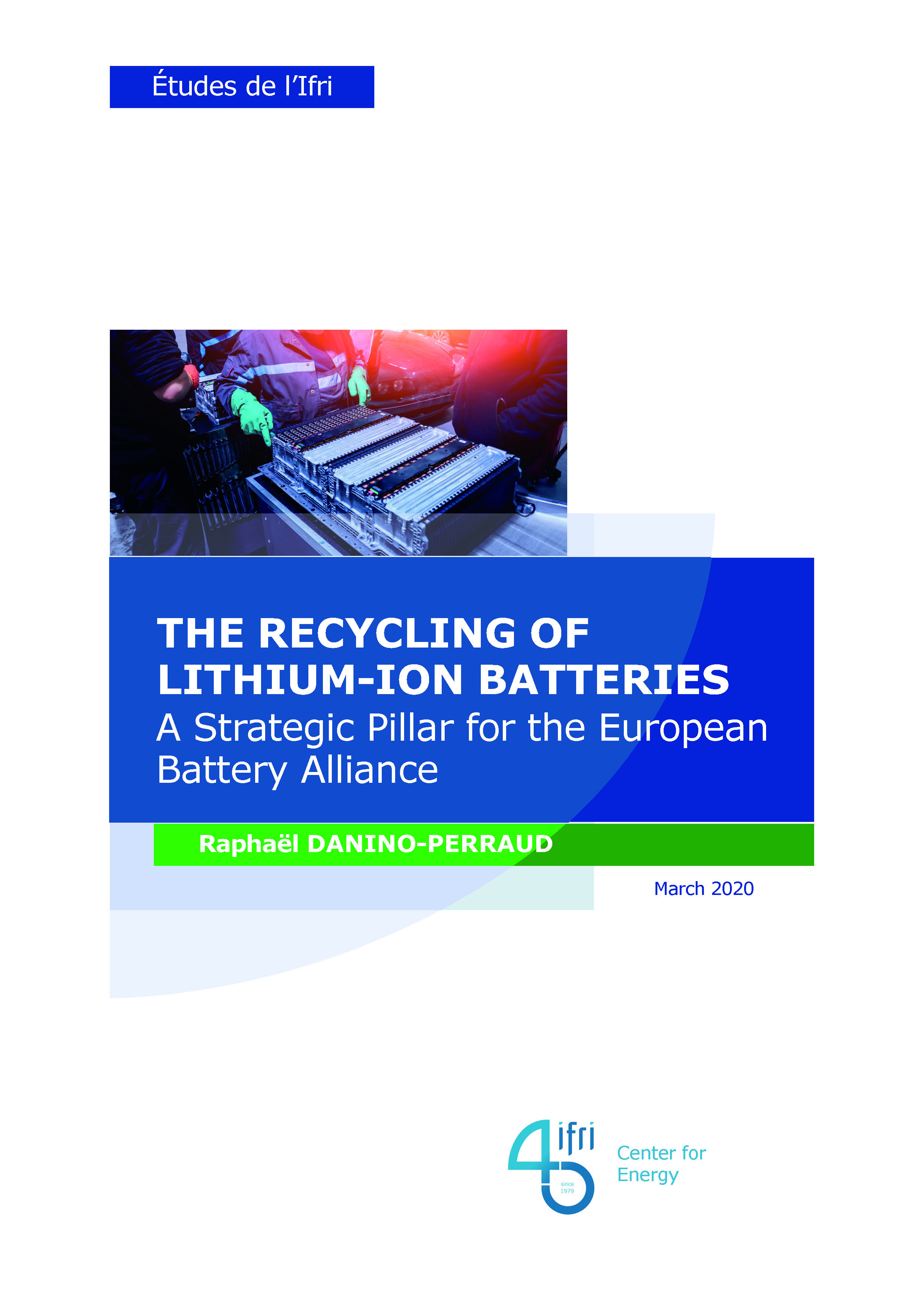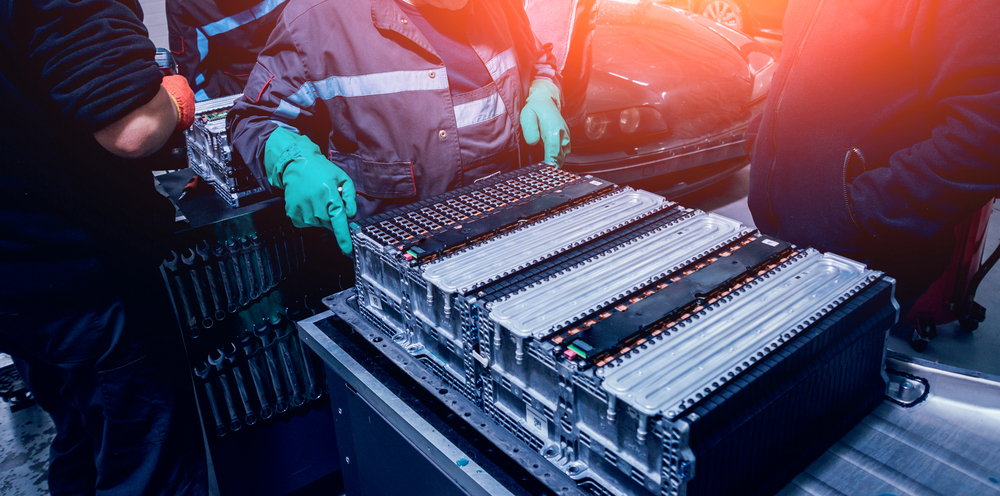The Recycling of Lithium-Ion Batteries: A Strategic Pillar for the European Battery Alliance

Although it is still marginal, the market for electric vehicles (EVs) is growing. According to the French Institute of Petroleum and Renewable Energies (IFPEN, Institut Français du Pétrole et des Énergies Renouvelables), EVs accounted for a little more than 2% of the light vehicle market in 2019. This was up by 54% compared to 2018, but EVs still only represent 0.8% of the global car fleet. That said, the International Energy Agency (IEA) estimates EVs could make up between 15% and 30% of vehicle sales in 2030.

However, while European manufacturers have so far developed EVs such as the Renault Zoé or the BMW i3, they are highly dependent on Asian companies for the supply and manufacture of materials for cells and electric batteries, such as nickel, cobalt, lithium used to build precursors, or cathodes and their components. Asia provides more than 90% of world car battery output, half of which comes from China alone. European dependence is not only related to the manufacture of batteries, but occurs throughout much of their value chain, from extraction and processing of raw materials to the preparation of necessary treatment processes for recycling. The recycling market for batteries from small electronic objects (smartphones, computers, tablets, etc.) has also been led by Asian countries.
These imbalances have been identified by the European Commission (EC), which launched the European Battery Alliance (EBA) in 2017. Its aim is to make up for part of the backlog accumulated in the various segments of the battery value chain, and especially in recycling activities. The European Union (EU) carbon neutrality objective and the implementation of the Green Deal will accelerate the decarbonisation of the transport sector through the roll out of the electric mobility. This strengthens the strategic importance of the EBA and notably of developing a robust recycling industry, both from a geo-economic and environmental standpoint.
The recycling potential of batteries in the EU is significant and represents a triple challenge: i) environmental, because recycling allows energy savings compared to mining; ii) economic, because the development of a recycling infrastructure and an industrial ecosystem linked to electricity storage will create jobs and value; and iii) strategic, because it will allow the recovery of mineral resources which the EU does not exploit on its own lands, and which can be re-injected directly into EU industries.
However, there are many obstacles as the market is still uncertain and not very mature. The number of EVs is marginal, and most have not yet reached the end of their lives. This leaves many questions open about batteries’ life spans, their collection, their condition and their adaptability to recycling processes. The lack of knowledge about the manufacture and composition of batteries is an obstacle to the efficiency of recycling processes, and can even lead to technical accidents. Despite significant growth, the battery market remains characterized by rapid technological developments, which have a direct influence on the raw materials used. There are also many types of batteries used at a given time, which makes standardization of industrial recycling processes difficult and challenges their economic viability. Raw material markets are in turn subject to a degree of financial volatility which makes investments in recycling uncertain. Thus cobalt, considered to be the most profitable metal to recycle, saw its price triple between 2017 and 2019, then being divided by four in a few months, before rising again, though without returning to its previous levels. In addition, the growing use of nickel, which will partially replace cobalt by 2021, is forcing companies to change their operations from cobalt to nickel. There are similar questions about the “second life” for these batteries which could then be employed for stationary uses. These questions remain pending, and will only find their answers through the actual “practice” of recycling by European industry. The latter for its part still suffers from a lack of international players (with the exception of Umicore) and from the fragmentation, or even an absence, of certain segments of the value chain.
It is therefore necessary to provide the European industry with the regulatory and financial means to implement such “practice”. Thus, depending on the different stages of the battery life cycle, regulation should impose precise standards to encourage the sustainability of the European battery industry’s productive model as well as its integration. For this, mining should be favored which is environmentally and ethically responsible, as should be the production of secondary raw materials through recycling. The processing of the latter should be facilitated by eco-design and eco-manufacturing standards for batteries, permitting the standardization of manufacturing and hence the recovery of materials at lower costs. This will involve: rethinking the targeting and accounting of recycling; reorganizing collection systems by industries in avoiding distortions to economic models; implementing the certification of collection and recycling channels; and more importantly, speeding up the revision of the EU Batteries Directive in order to adapt it as quickly as possible to the new challenges faced by the industry. At present, the recycling obligation for lithium-ion batteries is only 50%, whereas it is 90% for lead-acid batteries. A life cycle analysis (LCA) approach also needs to be adopted, in order to measure the carbon impact of batteries during manufacture, their use or even their end-of-life management. This would allow better control of imports with excessive carbon footprints, or of exports of end-of-life batteries to countries that do not meet minimum environmental standards.
More generally, a systemic vision is necessary to design a framework for an integrated European industrial ecosystem, which allows horizontal cooperation between companies, while being supported financially, legislatively and strategically by Member States and the EC.
Download the full analysis
This page contains only a summary of our work. If you would like to have access to all the information from our research on the subject, you can download the full version in PDF format.
The Recycling of Lithium-Ion Batteries: A Strategic Pillar for the European Battery Alliance






